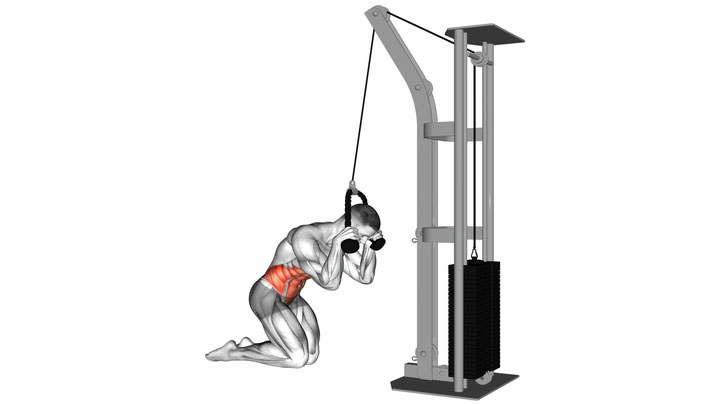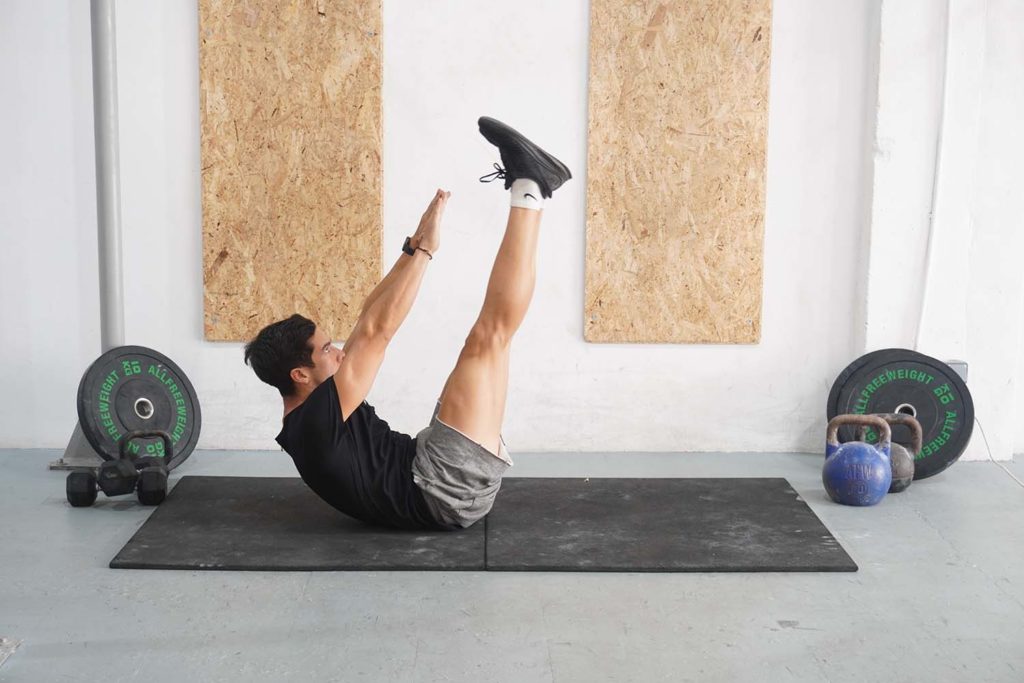What are heel taps?
Heel taps are a beginner-friendly exercise you can use to strengthen your obliques and rectus abdominis. The activity features a simple movement pattern that takes little time to learn. Plus, you don’t need any equipment for the exercise.
You can add heel taps to a simple home ab routine or do them as part of a gym workout. You can also add heel taps to a circuit routine if you enjoy doing metabolic conditioning training.
Doing heel taps is an excellent way to develop the more superficial muscles of your midsection, improve your stability, make you more athletic, and reduce your risk of spine-related injuries.
How to do Heel Taps

- Lie on the floor, bend your knees, and put your feet flat on the floor.
- Have your arms to your sides, your spine in a neutral position, and your knees pointing to the ceiling.
- Take a breath, engage your abs, and raise your head and upper back off the floor.
- Crunch to the right, bringing your right hand to your right heel.
- Once you tap your heel, straighten your torso and exhale.
- Take another breath and crunch to the left. Tap your left heel with your hand and go back to the starting position.
- Keep alternating between left and right until you finish the set.
What muscles do heel taps activate?
As briefly mentioned earlier, heel taps are a simple exercise that trains the superficial muscles in the midsection. The primary muscles engaged in heel taps are the obliques. These muscles are situated on either side of our rectus abdominis (the six-pack) and are responsible for torso rotation and crunching to the side (1, 2). Contracting our obliques allows us to crunch our torso to one side.
Our rectus abdominis muscle is also involved in heel taps, mainly to keep our shoulders off the floor. The muscle improves torso stability and crunches the torso by bringing the ribcage closer to the pelvic bone (3).
How to correctly perform heel taps?
The most important thing to keep in mind for heel taps is engaging your muscles and feeling them working. Too many trainees go through the motions, never focus on engaging the right muscles and stop themselves from making the best possible progress.
Another tip to keep in mind for heel taps is to use a full range of motion on every repetition. Meaning crunching to the side until your hand reaches your heel, then going back to the starting position. Doing so might not seem all that important, but it allows you to engage your obliques and abs better.
If you struggle to feel your midsection muscles during heel taps, consider adding a brief pause once you crunch your torso to either side. That way, you can work on your mind-muscle connection and improve muscle activity, leading to better growth.
The final tip to keep in mind is to keep your head and upper back off the floor throughout the set. Doing so will challenge you more and force your ab muscles to work extra hard to keep you in position.
Variations and Modifications of Heel Taps
1. Heel Taps With Crunches
The traditional way of doing heel taps is to assume a semi-raised torso position and maintain it throughout the set. The heel tap with a crunch is a variation where you do a crunch in-between every two taps. Here is how the sequence looks like:
Semi-crunch ⇒ Tap (left) ⇒ Tap (right) ⇒ Semi-crunch ⇒ Repeat
2. Pause Heel Taps
The pause heel tap is the simplest way to make the exercise more challenging and hopefully improve midsection involvement. Crunch to the side but hold the position for one to three seconds instead of going back immediately.
3. Weighted Heel Taps
The weighted heel tap is a great way to progress the movement once the bodyweight version gets to be too easy. The most straightforward way to do it is to grab a pair of light dumbbells and hold them as you do the exercise.
Mistakes to Avoid
A common mistake related to heel taps is doing the movement without paying any attention to muscle activation. Trainees would simply crunch to either side, aiming to finish the set as quickly as possible. The problem is that doing so prevents you from activating the correct muscles and forcing them to grow and strengthen. So, be mindful, and engage your midsection on every repetition.
Another common mistake related to heel taps is never making any improvements. Many people would start doing the exercise, reach an arbitrary repetition goal, and stop pushing themselves. The problem is that doing the same thing stops being productive.
Instead, you should keep challenging yourself to improve. Start with the bodyweight version, but find ways to keep working hard. Add extra weight, a brief pause, or introduce more challenging movements for your abs and obliques.
The final error to avoid relates to the range of motion, which is short, but some trainees manage to cut it even more. The issue is, doing so reduces muscle activation, making each repetition less effective. So, crunch as much as you can, then fully extend your torso on every repetition.
Similar Exercises to the Heel Taps
Cable Crunch

The cable crunch is an ab exercise you do with a rope attachment. The objective is to grab a rope, get down on your knees, and begin to crunch your torso. The exercise is effective because it offers an impressive overloading potential and a good range of motion.
V Up

The V up is a bodyweight abdominal exercise. The goal is to raise your torso and legs toward the ceiling simultaneously. In doing so, your body resembles the letter V when seen from the side. The movement is effective and relatively simple to learn, but it strengthens the core, which improves stability and athletic performance.
Side Lying Crunch
The side lying crunch is an overlooked but effective bodyweight exercise we can use to emphasize our obliques. You have to lie on one side and crunch your torso. The position puts your obliques at a mechanical advantage, which forces them to do most of the work.

